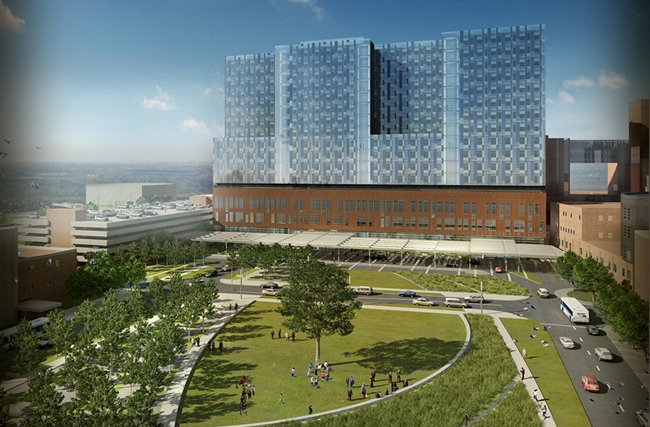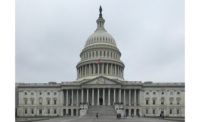
The Supreme Court issued its landmark ruling last Thursday on the Affordable Care Act, essentially upholding the law. Following up on a story we published last week, we checked in with architects and industry experts around the country to hear their thoughts on the decision and how it might affect health care architecture. Share your own opinions in our reader survey.
Jennifer Coskren, senior economist with McGraw-Hill Construction
Health care construction starts have dropped in recent years—and the decline persists. Through May of this year, total starts (in square footage terms) were down 24 percent. Coskren says the ruling should help jump-start projects, even while the economy continues to limp along. “Now that the uncertainty is gone thanks to the Supreme Court upholding the constitutionality of the law, we feel that the industry will be able to move more confidently ahead with capital expenditure plans,” she says. “Demand for health care services are expected to increase, thanks to the over 30 million people who now will have access to health care insurance.”
John Schneidawind, based in Washington, D.C., AIA media spokesman
The AIA didn’t take a stance on the health care reform law. Now that the Court has upheld it, Schneidawind says the AIA will “continue to educate its members on how the law affects them and what they need to do in order to prepare for its implementation.” He adds: “At the same time, we are continuing to monitor legislative action on health care and other issues that affect the practice of architecture.”
Mary-Jean Eastman, based in NYC, founding principal of Perkins Eastman
“I think our clients are taking a big collective sigh of relief,” says Eastman. “They have some sense of where things are going and are able to plan for the future.”
Eastman believes the decision will spur design work, although architects likely will be focusing on primary-care facilities and optimizing efficiencies in existing hospitals. “It will definitely affect the way we design the environments. It will be about quality, not quantity, which is probably a good thing,” she says. “In the Northeast, we don’t need more beds. It’s an issue of having the right beds.”
Michael Pukszta, based in St. Louis, chair of Cannon Design’s health care steering committee
“I see this ruling as step one out of 20 more steps,” Pukszta says. “The decision helps us understand the direction we are going as a country, but it will take a year or more to really understand what it means for our hospital clients.”
Cannon’s health care clients are mostly large hospital systems. Many clients are at capacity and need more space, but they are hesitant to build facilities because they can’t forecast their revenue. “The demand is there, and it’s not the resources—most of them have the dollars—but not knowing the return on investment is making them pause,” Pukszta explains. Regardless, he believes the market will improve. “The types of buildings we are designing are going to change a little bit,” he says, “but in general there will be a strong health care market for a decade to come.”
He says his firm has already started designing “hyper-adaptable” spaces that can accommodate changing needs. For instance, it has created ambulatory spaces that can later be converted into patient rooms. “We are designing buildings that can do anything in their lifetime,” he says.
Jean Mah, based in Los Angeles, health care market sector leader for Perkins+Will
Mah’s take on the ruling: Proceed with caution. “The Court’s decision will remove a lot of the uncertainty, so it’s good news for health care clients and owners” who want to act on facility and planning projects. Still, they will be cautious given the upcoming presidential election.
She expects clients will continue to invest in health information recording systems, and the industry will continue to see the consolidation of physician networks. In terms of facilities, clients are likely to move ahead “with some proposed projects, especially in areas of current underserved and unserved populations,” she says. “Public hospitals are facing the biggest challenges to providing for these groups, as their demand will increase while their access to funding is harder to get.”
Charles Griffin, based in Texas, senior principal at WHR Architects and board member of the AIA’s Academy of Architecture of Health
“Most successful healthcare systems have already factored in the ACA and the SCOTUS ruling into their current planning. They have been moving forward with non-facility based changes to their business,” Griffin says. These changes include creating accountable care organizations, investing in IT infrastructure, engaging more primary care doctors in group practice acquisitions, and improving overall efficiency.
The Court’s ruling, he says, will enable his clients to “continue thinking about facility improvements that reinforce the direction of the ACA.” Of course, the outcome of the fall presidential election could disrupt that stability, he notes.
Jim Hannon, based in San Francisco, director of SmithGroupJJR’s health care practice
Hannon believes the Supreme Court’s decision gives his clients assurance and alleviates the uncertainty that was preventing them from moving forward with certain projects. Overturning the law would have slowed projects even further.
In the long term, Hannon expects that architects specializing in health care will be working on a “broader bandwidth” of buildings. “I don’t see a huge boom for hospitals as a building type, although there certainly will be places in the country where new acute-care facilities are built,” he says. “The real gain is in other health care venues, places you go before and after the hospital: primary-care facilities, outpatient facilities, post-acute facilities, rehabilitation facilities, continuing care.”
Hannon says these facility changes fall in line with shifts already occurring in the health care industry. “I’m a strong believer that most or all of the major drivers that were encouraged by the Affordable Care Act were already happening, particularly the move toward greater integration of health care services and systems of accountability,” he says. “This quickens the pace of that and clarifies the rules of the game.”
Martin Valins, based in Philadelphia, principal at Stantec
“This ruling needs time to gain momentum,” he says. “I don’t see it having an immediate impact on architects’ projects.” He says the uncertainty isn't quite over yet: The outcome of the November election will also have an effect on health care projects in the long-term. “If the current administration continues, this legislation will take a foothold.”
For those currently working on hospital projects, he says special attention should be paid to emergency rooms. “It may be worth thinking about how to make them more flexible,” he says, noting that they should perhaps include primary-care functions. “If everyone has a primary care doctor, the ER will begin to fade.”
Sheila Cahnman, based in Chicago, group vice president and regional health care leader at HOK
Cahnman says the health care industry can proceed with more certainty. Still, she notes, “health systems are still unsure of their projected revenues,” and they predict those revenues will decline, regardless of the new law. In turn, “they will continue to push for improvements to lean their operations and increase their bottom lines,” she says.
She hopes health care clients will start to look at improving their infrastructure, “including upgrading existing chassis so they can support lean operations or improved patient satisfaction.” She also foresees an increased emphasis on outpatient facilities.



Post a comment to this article
Report Abusive Comment